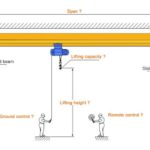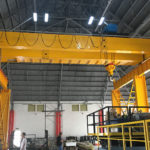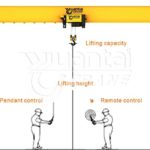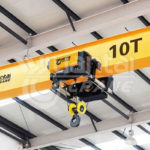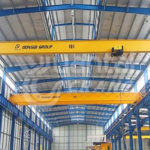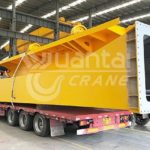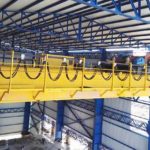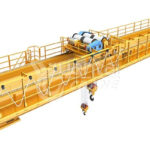Overhead Crane Installation&Bridge Crane Installation Overview
Overhead cranes and bridge cranes are types of lifting equipment that can be used to move heavy loads in industrial settings. They are composed of a horizontal beam, called a bridge, that runs along two parallel rails, and a hoist that can move along the bridge. The hoist can lift and lower the load using a hook, a magnet, or a grab.
Overhead crane installation and bridge crane installation are complex and delicate processes that require careful planning, preparation, and execution.
Overhead Crane Installation Method Statement | Overhead Crane Installation Procedure
- Site inspection: Before installing an overhead crane or a bridge crane, it is important to inspect the site and assess the conditions, such as the available space, the floor strength, the power supply, the lighting, the ventilation, and the safety measures. The site inspection will help to determine the best location, size, and configuration of the crane, as well as the necessary equipment and personnel.
- Crane selection: Based on the site inspection and the requirements of the project, the next step is to select the most suitable crane for the job. There are different types of overhead cranes and bridge cranes, such as single girder, double girder, top running, under running, etc. Each type has its advantages and disadvantages, depending on the load capacity, span, height, speed, duty cycle, and control system. The crane selection should also consider the budget, the delivery time, and the warranty of the crane manufacturer or supplier.
- Crane installation: Once the crane is selected and delivered to the site, it is time to install it. The installation process may vary depending on the type and model of the crane, but it generally involves the following steps:
- Assembling the components: The crane components, such as the bridge, the end trucks, the hoist, the trolley, the electrical system, etc., need to be assembled according to the instructions provided by the manufacturer or supplier. The components should be checked for any damage or defect before assembly.
- Mounting the rails: The rails are the tracks that support and guide the movement of the bridge. They need to be mounted on the supporting structure of the building or columns or gantries. The rails should be aligned and levelled properly to ensure smooth and safe operation of the crane.
- Installing the bridge: The bridge is the main part of the crane that spans across the rails. It can be installed using a mobile crane or a forklift. The bridge should be secured to the end trucks and connected to the electrical system.
- Installing the hoist: The hoist is the device that lifts and lowers the load using a hook, a magnet, or a grab. It can be mounted on a trolley that runs along the bridge or directly on the bridge. The hoist should be attached to the lifting mechanism and connected to the control system.
- Testing and commissioning: After installing all the components of the crane, it is necessary to test and commission it before putting it into operation. The testing and commissioning process involves checking all the functions and features of the crane, such as:
- The alignment and levelness of the rails
- The clearance and stability of the bridge
- The movement and speed of the hoist and trolley

How Much Does an Overhead Crane Installation Cost?
The cost of installing an overhead crane depends on several factors, such as the type, size, capacity, and configuration of the crane, the complexity of the installation site, the labour and material costs, and the duration of the project. According to some estimates, the average cost of installing an overhead crane ranges from $25,00 to $150,00, depending on these variables. However, this is only a rough approximation and the actual cost may vary significantly depending on the specific circumstances of each project. Therefore, it is advisable to consult with a professional crane installer before making any decisions or budgeting for an overhead crane installation.
Overhead Crane Requirements | Overhead Crane Certification
- The crane must be designed and manufactured according to the applicable standards and specifications, such as ASME B30.2, OSHA 1910.179, and ANSI/ASCE 7.
- The crane must be inspected and tested regularly by qualified personnel, and any defects or malfunctions must be corrected promptly.
- The crane must be operated by trained and authorized operators, who follow the manufacturer’s instructions and the employer’s safety rules.
- The crane must be equipped with safety devices, such as limit switches, emergency stop buttons, warning lights, horns, and load indicators.
- The crane must be maintained and lubricated properly, and any worn or damaged parts must be replaced as soon as possible.
- The crane must be used only for the intended purpose and within the rated capacity and speed.
- The crane must not be overloaded, over-speeded, or subjected to shock loading or swinging.
- The crane must not be operated near power lines, flammable materials, or other hazards that could cause electric shock, fire, or explosion.
- The crane must not be used to lift or transport people unless it is specifically designed and approved for that purpose.
